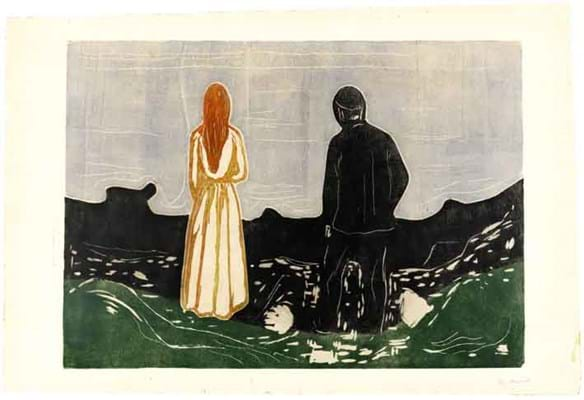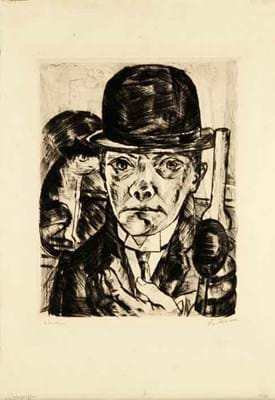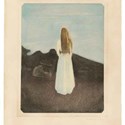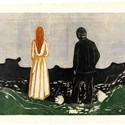This was particularly true of the copy ofYoung Woman on the Beach, which sold at Christie's in King Street on March 20 and set a new high for a print by the artist.
The theme of the isolated figure on the shoreline can be traced back to a passage in one of Munch's journals from the early 1890s, when he wrote of a woman in a white dress placed "against the blue of the booming sea - with the sinuous snake-like curves of the shoreline". He also painted a work entitled Two Human Beings: The Lonely Ones in 1891-92 (now lost but known through later woodcuts and lithographs), which had marked similarities to this image.
The 11½ x 8½in (29 x 22cm) work at Christie's was a fine and delicate impression of this important print.
An innovative printmaker, Munch produced this aquatint and drypoint in a particularly unusual way.
Using zinc plates prepared earlier with aquatint, the artist inked each print individually by hand in different colour combinations, before scraping into the image with a burnisher to delicately modulate the effects in a manner not dissimilar to mezzotint techniques.
The result was that these images varied greatly in mood and character. Each one was effectively unique and the differences between them was brought about entirely by the artist's direct involvement.
Rarity Value
Munch's aquatints are much rarer than his other prints because he only produced them over a very short period between 1896 and 1897 while in Paris.
Only 11 impressions of Young Girl on the Beach are known (with seven types of colour variants, according to Gerd Woll who complied Munch's catalogue raisonée). In some examples the girl is bathed in the light of the setting sun, giving the print a euphoric sense, but here the mix of pale blue, brown, grey and pink gave a more sombre mood, with the figure appearing to flicker like a flame in the twilight.
This impression was therefore arguably the subtlest in terms of its nuances and effects.
Its provenance was also interesting.
It had been in collection of the art historian Curt Glaser, who was director of the Kupferstichkabinett (the Print Room of the State Museums in Berlin) during the 1920s and was one of the artist's first great supporters.
Dismissed from his position by the Nazis in 1933, he was forced to sell his art collection to finance his emigration, and this print, among others, was bought by the Kupferstichkabinett where it remained until last year, when it was restituted to Glaser's heirs.
With seemingly no copy having emerged at auction for at least a generation, the print drew bidding from the key players in the Munch market. Estimated at £500,000-700,000, it sold at £1.85m to Oslo's Galleri K, who were bidding for a private collector.
The price was significantly above the previous highs for a Munch print - the £1.1m seen for both a copy of his Madonna lithograph at Bonhams in London in July 2010 and Vampire II, which sold at Oslo saleroom Grev Wedels Plass Auksjoner in November 2007 for NKr11.8m.
In terms of the all-time record auction prices for any individual print, it stands only behind these results achieved by a number of Andy Warhol silkscreens and the copy of Pablo Picasso's La femme qui pleure, I from 1937 that took $4.5m (£2.95m) hammer at Christie's New York in November 2011.
Asian Demand
While big-spending collectors of Munch prints tend to come from America as well as Scandinavia, demand from new markets might also have been a factor here. Certainly this was the case with another lot from the Glaser collection at Christie's - the copy of Munch's 1902 woodcutOld man prayingestimated at £30,000-50,000. Thought to depict the artist's father, it sold to an Asian private buyer at £65,000.
Meanwhile, over at Sotheby's on March 19, a European dealer purchased a copy of Munch's above-mentioned woodcut Two Human Beings: The Lonely Ones.
Dating to 1899, it appeared to feature the same female figure on the shoreline as the slightly earlier Young Woman on the Beach at Christie's, but this time she was accompanied by a man in dark clothing.
Again there was a tangible sense here of Munch's own direct involvement - he had carved his own blocks and cut them into shapes which he reassembled like a jigsaw. As well as the pale blue, black and green colours, this impression displayed a striking use of a rich red and brown, which gave the woman an elusive and captivating presence not unlike the print at Christie's.
Estimated at £250,000-350,000, it sold at £820,000. This was the highest price for a copy of this print at auction, although ultimately it was never likely to reach the level of Young Woman on the Beach as it was not as rare - indeed another copy of Two Human Beings: The Lonely Ones with less attractive colours appeared in the same Sotheby's sale and sold below estimate at 'only' £85,000.
German Expressionists
Both Sotheby's and Christie's also had a range of prints by German Expressionists - a movement for which Munch is often credited with preparing the ground - but here reaction was more mixed, again because more are available.
Sotheby's offered Kühe im Frühling, a rare woodcut from 1933 by Ernst Ludwig Kirchner (1893-1959), for which the artist used three blocks that, like Munch, he had cut apart, inked and then reassembled for the printing process. With seven different colours, this copy was billed by the auctioneers as a 'tour-de-force' in modern printmaking, using techniques that the artist had spent many years perfecting.
Estimated at £80,000-120,000, it sold below estimate to a European private buyer at £70,000.
Christie's meanwhile had a series of prints by Emil Nolde (1867-1956), including a copy of the woodcut Fischdampfer from 1910. Depicting a trawler, it was also produced by cutting the image into woodblocks. Estimated at £15,000-25,000, it sold at £26,000.
Making a higher sum but drawing less bidding was Max Beckmann's (1884-1950) Selbstbildnis mit steifem Hut (Self-Portrait with Bowler Hat), a heavily worked self-portrait from 1921. The drypoint impression was made by scratching the image directly onto a metal plate but then radically revised by adding and burnishing out entire elements of the composition.
Examples from the first edition of around 50 copies come up occasionally at auction and this one had previously been sold at Christie's New York in November 1988 as part of the Neuerburg collection (which featured perhaps the best group of German Expressionist prints ever offered at auction).
Back then it fetched $88,000 (£43,000) but here it took a low-estimate £70,000 from a UK dealer.
The buyer's premium at Sotheby's and Christie's was 25/20/12%.










